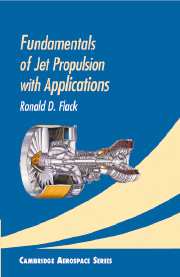Book contents
- Frontmatter
- Contents
- Preface
- Foreword
- Part I Cycle Analysis
- Part II Component Analysis
- 4 Diffusers
- 5 Nozzles
- 6 Axial Flow Compressors and Fans
- 7 Centrifugal Compressors
- 8 Axial Flow Turbines
- 9 Combustors and Afterburners
- 10 Ducts and Mixers
- Part III System Matching and Analysis
- Part IV Appendixes
- References
- Answers to Selected Problems
- Index
6 - Axial Flow Compressors and Fans
Published online by Cambridge University Press: 05 June 2012
- Frontmatter
- Contents
- Preface
- Foreword
- Part I Cycle Analysis
- Part II Component Analysis
- 4 Diffusers
- 5 Nozzles
- 6 Axial Flow Compressors and Fans
- 7 Centrifugal Compressors
- 8 Axial Flow Turbines
- 9 Combustors and Afterburners
- 10 Ducts and Mixers
- Part III System Matching and Analysis
- Part IV Appendixes
- References
- Answers to Selected Problems
- Index
Summary
Introduction
As discussed in previous chapters, a fan or compressor is the first rotating component that the fluid encounters. A cross-sectional view of a compressor for a simple, single-shaft turbojet is shown in Figure 6.1. The basic function of a compressor is to impart kinetic energy to the working fluid (air) by means of some rotating blades and then to convert the increase in energy to an increase in total pressure, which is needed by the combustor. The limits of operation of an engine are often dictated by a compressor, as is discussed in this chapter. Furthermore, the design of an efficient axial flow fan or compressor remains such a complex process that the success or failure of an engine often revolves around the design of a compressor. Many fundamental and advanced design details are available in Cumpsty (1988), Hawthorne (1964), Horlock (1958), Howell (1945a, 1945b) and Johnsen and Bullock (1965). Rhie et al. (1998), LeJambre et al. (1998), Adamczyk (2000), and Elmendorf et al. (1998) demonstrate how modern computational fluid dynamic (CFD) tools can effectively be used for the complex three-dimensional analysis and design of compressors.
Compressors were the main stumbling block of the early engines and the primary cause of the delays in the development of jet engines for World War II. Dunham (2000) and Meher-Homji (1996, 1997a, 1999) present interesting historical perspectives and technical information on early compressor development.
- Type
- Chapter
- Information
- Fundamentals of Jet Propulsion with Applications , pp. 276 - 373Publisher: Cambridge University PressPrint publication year: 2005



